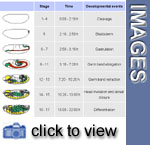Stages
 The
embryonic development of Drosophila melanogaster has been subdivided
into 17 stages by Volker Hartenstein and José Campos-Ortega. Staging
according to these authors has become a general reference in Drosophila
research.
The
embryonic development of Drosophila melanogaster has been subdivided
into 17 stages by Volker Hartenstein and José Campos-Ortega. Staging
according to these authors has become a general reference in Drosophila
research.
 Embryonic
stages are defined by prominent features that are easily distinguishable
in the living Drosophila embryo. The duration
of the various stages indicated in the text refers to embryos developing
at 25°C. We wish to emphasize that most of the data described here
are average values obtained from observations
on several different embryos. Due to difficulties in precisely defining
the beginning and end of most of the relevant stages, there is some variability
in the timing of stages, so that the times given in the following documents
should be understood as approximations.
Embryonic
stages are defined by prominent features that are easily distinguishable
in the living Drosophila embryo. The duration
of the various stages indicated in the text refers to embryos developing
at 25°C. We wish to emphasize that most of the data described here
are average values obtained from observations
on several different embryos. Due to difficulties in precisely defining
the beginning and end of most of the relevant stages, there is some variability
in the timing of stages, so that the times given in the following documents
should be understood as approximations.
 The
egg is bilaterally symmetrical, and distinction between the dorsal and
ventral surfaces is indicated by differences in curvature, for the dorsal
side is flattened while the ventral side is somewhat convex. The dimensions
of the egg are variable; an average length is 500 µm, the diameter
is about 180 µm.
The
egg is bilaterally symmetrical, and distinction between the dorsal and
ventral surfaces is indicated by differences in curvature, for the dorsal
side is flattened while the ventral side is somewhat convex. The dimensions
of the egg are variable; an average length is 500 µm, the diameter
is about 180 µm.
The mature egg is enclosed by two envelopes, an
inner homogeneous vitelline membrane and an outer tough, opaque chorion.
The chorion is not structureless but rather ornamented with hexagonal
and pentagonal figures. These ornamental markings represent the impressions
of the ovarian follicle cells on the originally soft, plastic membrane
secreted by the follicular epithelium. Paired delicate filaments –
extensions of the chorion – are situated on the dorsal surface not
far from the anterior end of the egg. The micropylar opening for the passage
of sperm is generated by the vitelline membrane. It indicates the anterior
pole of the embryo.
 When
the chorion is removed one may directly observe certain aspects of the
developmental processes through the transparent, structureless vitelline
membrane, which is closely apposed to the protoplasmic contents (see also
the time lapse movie "Embryogenesis,
in vivo").
When
the chorion is removed one may directly observe certain aspects of the
developmental processes through the transparent, structureless vitelline
membrane, which is closely apposed to the protoplasmic contents (see also
the time lapse movie "Embryogenesis,
in vivo").
Media list